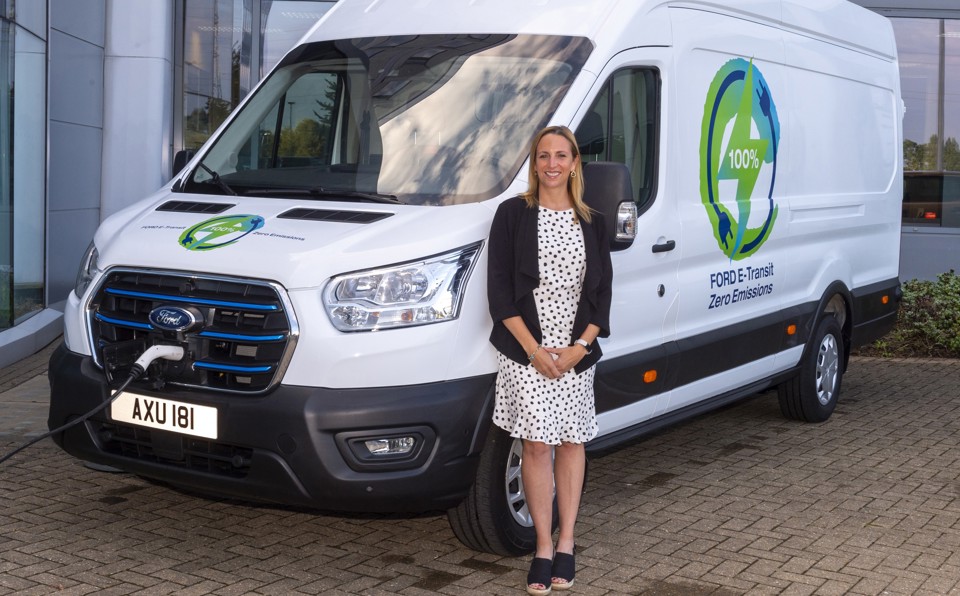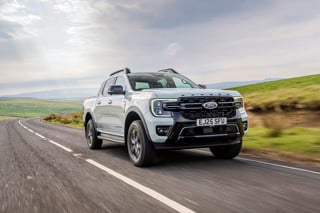Over the past three years, Ford Pro has been “joining the dots” as it strives to provide the “optimum service” for fleets. Key to this aspiration is introduction of initiatives to help simplify the business of running vehicles for customers.
While simultaneously juggling vehicle and parts availability and managing the run out and launch of key products, the company has been removing cost, improving communications and minimising downtime.
A major project has sought to shorten the time vehicles spend with converters by changing specifications and bringing some elements in house.
“Some customers say we only give them 95% of the van because they have to convert it; we are aiming to get closer and closer to 100% which will reduce cost and reduce lead times,” said Neil Wilson, fleet director, Ford of Britain, who collected the Fleet News Van Manufacturer of the Year trophy at this year’s awards.
One example is Ford’s Digital Fit initiative which reduces the amount of hardware in the cab, including handheld devices, by uploading the software to the vehicle.
“It removes the need for a third party and makes the conversion easier,” said Wilson. “Removing the handheld device also de-clutters the cabin.”
A contract with The AA has seen its Toughbook tablets replaced by the Ford Pro Upfit Integration System. It integrates the control of specialist tools and equipment into the van’s factory-fitted 13‑inch display, enabling patrols to activate everything from LED hazard beacons to breakdown diagnostics, jump-start connection points and towing equipment from the touchscreen.
It means The AA no longer needs to combine equipment from 11 different companies.
Ford Liive saves fleets £300m in 2023
Ford Liive, the uptime management system launched in 2021, has also played a significant role in improving the performance of fleets by monitoring vehicle health and addressing problems before they result in significant downtime.
Much of the work required to manage reams of data from the connected services can be done by Ford Pro, with outputs relayed to the dealer network for resolving.
During 2023, Ford Liive, now running on 208,000 vans, reduced downtime by 500,000 days through interventions that would not have previously been possible. At a conversative estimate of £600 lost revenue per day, Ford Pro claims the saving equates to £300 million, an average of £1,500 per van over the course of a year.
Ford targets 11% growth on back of new models
The first two months of 2024 have seen a slight 7.7% year-on-year dip in Ford Pro registrations on the back of a drop in market share last year. Both results are explained by lack of supply due to model transitions, but with production volumes steadily rising, it expects to end the year up 11% on 2023.
New Ranger and Courier are now available with no constraints after their recent launches, while new Custom is also in showrooms, with a plug-in-hybrid option due this summer described by Wilson as “an interesting proposition” for customers.
“It’s a step towards full electric and helps fleets to move in the right direction where the use case doesn’t currently work,” he said.
Ford Pro will also launch PHEV versions of Connect by year-end, offering 62 miles of electric-only range, and Ranger in Q1 2025. Within the space of a year, its entire light commercial vehicle line-up will be new and available with electrified options.
“PHEV helps demystify electric and plugging in; it makes it easier to transition and is part of the long-term move to electrification,” Wilson said.
“But it also means fleets can tow with no compromises and even when the battery is depleted, the van will operate like a full hybrid so you will still have some running with the battery.”
Ford Pro is deploying E-Switch Assist, a telematics product which helps fleets to identify the vans that can change to full electric. It is facilitating the journey by providing consultancy services to support depot charging which are now being extended to home charging.
Mandy Dean, Ford Pro director of commercial vehicles (pictured top), said: “It’s all about the software solution with smart charging for reimbursement back to the employer. Home charging can be complementary to depot charging and, with the Blue Oval public charging network, we can help to fill the gaps.”
EV adoption exceeds customer expectations
Data from E-Switch shows that, in almost every case, the scope of electric adoption far exceeds customer expectations. Allied to this are the discussions around the Ford product roadmap and the implications for future supply.
That roadmap tracks ahead of the requirements under the ZEV Mandate which came into force this year.
“We had the plan for five years on when product comes to market – there are no surprises,” said Dean. “We are on track to meet the needs of our customers to make the transition. We plan to be compliant with all the targets.”
As the UK market leader, with more than 30% market share, this is an important statement, one which lays down the gauntlet to others, but also is a reminder to fleets that they need to keep pace.
“The time to start EV adoption is now – don’t leave it too late,” Wilson said, although he accepts that for the next few years fleets will “still need a range of technology – all customers are different”.
One question repeatedly asked by companies considering starting their transition is whether dealers will be able to cope with aftersales business.
Andy Paton, commercial vehicle and fleet aftersales manager, states emphatically: “The answer is yes! We have accelerated our technician training and invested in the equipment, and we have enough to cope around the battery and inside the battery.”
So far, there has been no appreciable difference in the time taken for a diesel van to enter a workshop and work to begin compared to an electric van. But repair and service times on the electric vehicles are shorter due to the fewer moving parts.
Free vehicle health checks and service reminders
Then there is the heightening level of connectivity via Ford Liive which provides free of charge vehicle health alerts and service reminders to fleets, as well as dealers to help both plan ahead.
“Because of the connectivity we can look at every vehicle every day to identify any issues,” said Wilson. “We pre-diagnose so dealers can order parts in advance. We can also coincide the repair with a scheduled service and plan the correct technician to minimise off-road times.”
Compared to an unannounced arrival at a workshop, the pre-diagnosis can reduce downtime by “at least a couple of days”, he added.
Dealers have access to a dashboard which contains all the key information, including the previous 60 days of health check data. It also highlights when any fault codes were ignited to present a clear picture of activity.
The system also enables Ford to identify and track potential trends resulting from common faults more easily and quickly. They can then be addressed and resolved before they become an issue for other fleets.
Put simply, Ford Liive aims to apply the just-in-time manufacturing process to the dealer workshop by identifying and removing all the points of waste from the transitional process.
At the Ford Liive centre in Dunton, Essex, a giant 9m x 1.7m screen dominates the main wall. On it are live updates of four key performance indicators in the uptime reporting suite:
- Vehicle is productive – no action required.
- Vehicles overdue a service or service due within 30 days.
- Vehicle is still on the road but a repair is required.
- Vehicle is off-the-road in a workshop (this is 1% of the connected fleet).
Ford has seen a rise in the proportion of vans sitting in pool one and a reduction in those in pool three.
Also displayed on the board are CSI performance, inspection times, lead times at the dealership (target is within three days) and key-to-key repair times (currently six days).
While the vehicle is off road, Ford keeps the customer moving by providing a capable alternative vehicle. And if it can’t, it will provide loss of use to enable the fleet to rent an appropriate van from another source.
All the while, Ford Liive agents coordinate communications to keep the customer fully informed of progress.
Paton said: “We can translate what is happening in the dealership and when they will get their vehicle back. We manage the entire process from the Ford Liive centre.”
Wilson added: “We support our network with their relationship with their customer and we can also reach out to the dealer to see if they need support. We join the dots to provide the optimum solution for customers.”
Launched to support van customers, Ford Liive connectivity is also available on cars, but isn’t enjoying the same groundswell of support.
Paton explained: “It is easier to solve off-road problems with cars by giving them the keys to another vehicle; they don’t have the same urgency. We have the same connectivity, and we expect it will evolve over time, but there isn’t the same demand from customers for this type of service.”
Given the clear benefits Ford Liive offers vans fleets, it’s perhaps surprising that the 208,000 vehicles currently connected account for just 45% of the Ford van parc. Some vehicles are partially activated, other fleets have declined.
“It’s about awareness; we need to get the message out there about the benefits,” Wilson said.
Subscription service boosts data insight
The next evolution is Ford Liive Plus, a subscriptions service which elevates the level of data and insight provided to fleets.
Ford Liive Plus was borne from a realisation that, despite offering free-of-charge telematics in its vehicles, fleet managers were not looking at the data. Why? They were simply too busy.
“So a year ago, we started to do it for them,” said Owen Gregory, director, Ford Pro Service. “Customers pay us to monitor the telematics data and identify any work that needs to be done. We do a triage on our mobile network and workshops and facilitate bookings to deliver the lowest downtime for the customer.”
An initial pilot with one “very well-known fleet” has halved downtime, presenting a clear return on investment argument for the fleet manager.
Another test case resulted in a 300-vehicle fleet operating in tough conditions having, for the first time ever, a month with no roadside issues. Previously, they were a common occurrence.
The Ford Liive Plus subscription - pricing is still to be finalised – includes data monitoring, driver behaviour from the telematics and GPS location.
As part of the onboarding process, fleets are offered a free three-month trial to demonstrate the value of the proposition. Six fleets are currently in the pilot phase.
It’s a multi-marque solution, too, with Ford’s mobile network able to carry out most servicing and scheduled maintenance work for other van brands.
Remote diagnistics points way to 'self-healing' vans
Ford is also piloting its first completely remote diagnostics solution with a rental company whereby the vehicle will self-diagnose a repair and communicate with the fleet and the dealer.
Gregory said: “This will become smarter as we add more sensors – we are heading towards a self-healing vehicle. The next step is to identify the things that cause the most avoidable pain.”
He added: “If we look at the next generation of vehicles, there’s a list of 60 or so things that we want to do remotely. Our guiding principle is to design everything to be repaired by a mobile van or to be prevented, so the only reason a vehicle would be off-road in a workshop would be a collision. This is a multi-year journey.”
Today, around 70% of jobs carried out in a workshop could be done by one of Ford’s 137 mobile vans (to become “close to 170” by the end of 2024). The current network accounts for 15%-plus of all dealer SMR work; expanding to 250 would absorb up to a third.
Work can also be carried out at the customer’s depot in the evening, effectively eliminating downtime to “transform fleet productivity”.
The service is a key part of the Ford Pro proposition, according to Gregory. “Mobile servicing is the biggest change to vehicle maintenance since the invention of the vehicle!” he said.






















Login to comment
Comments
No comments have been made yet.